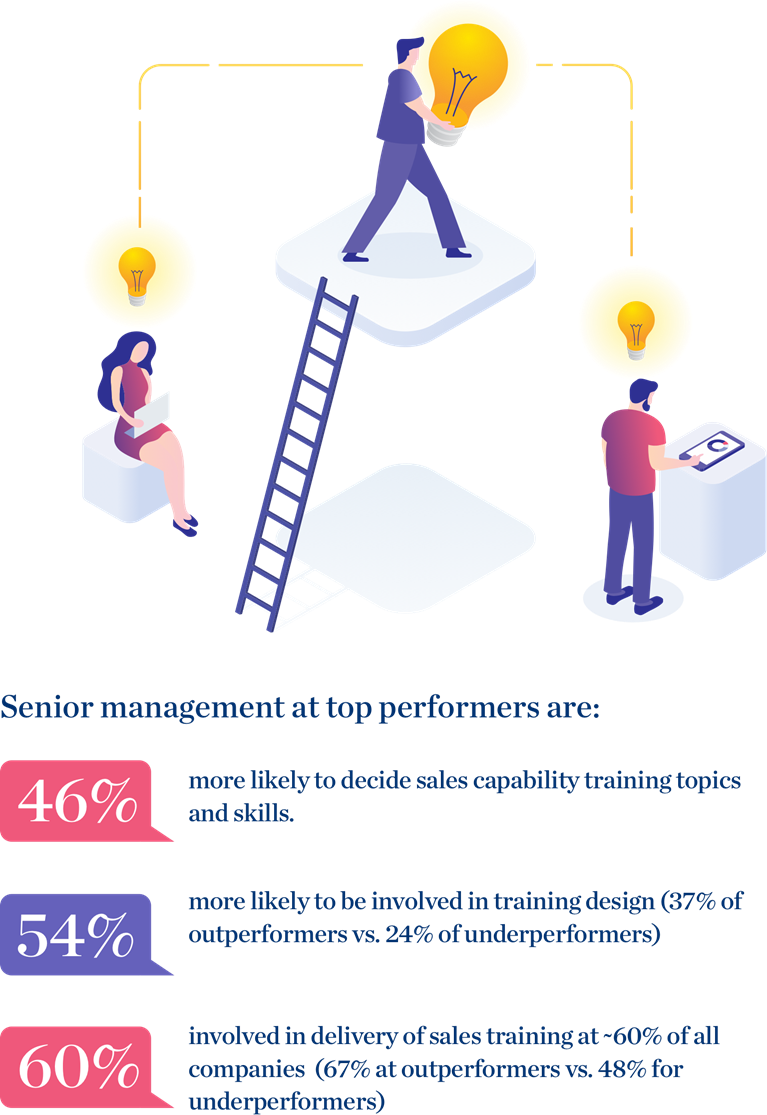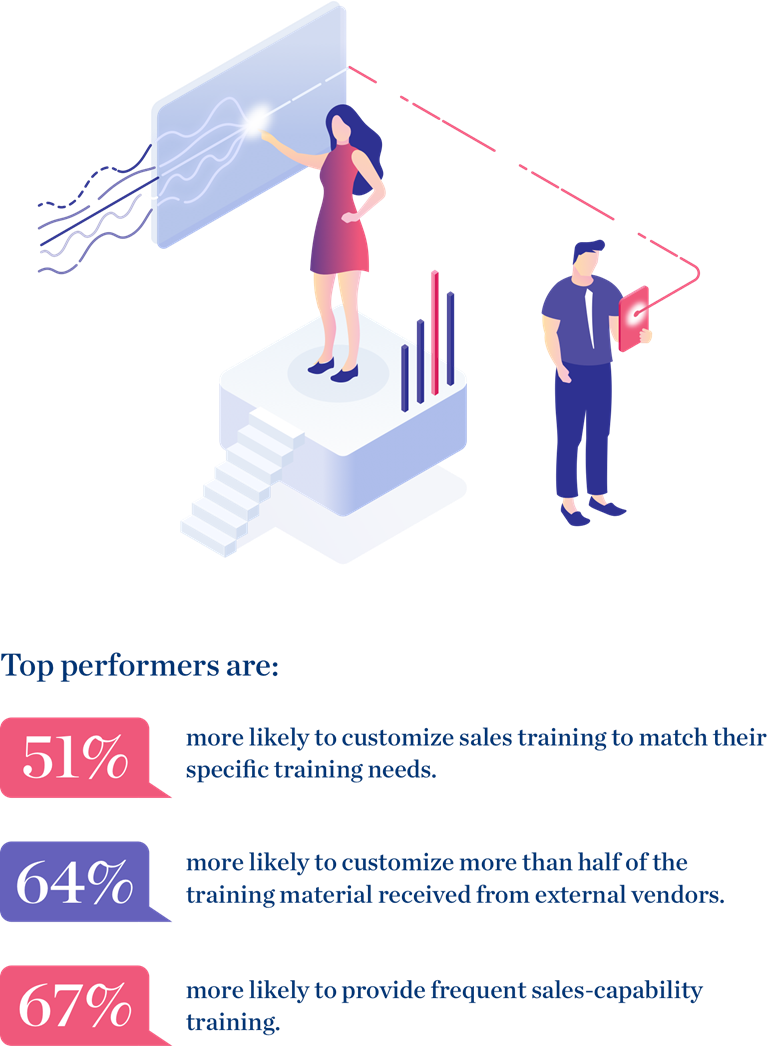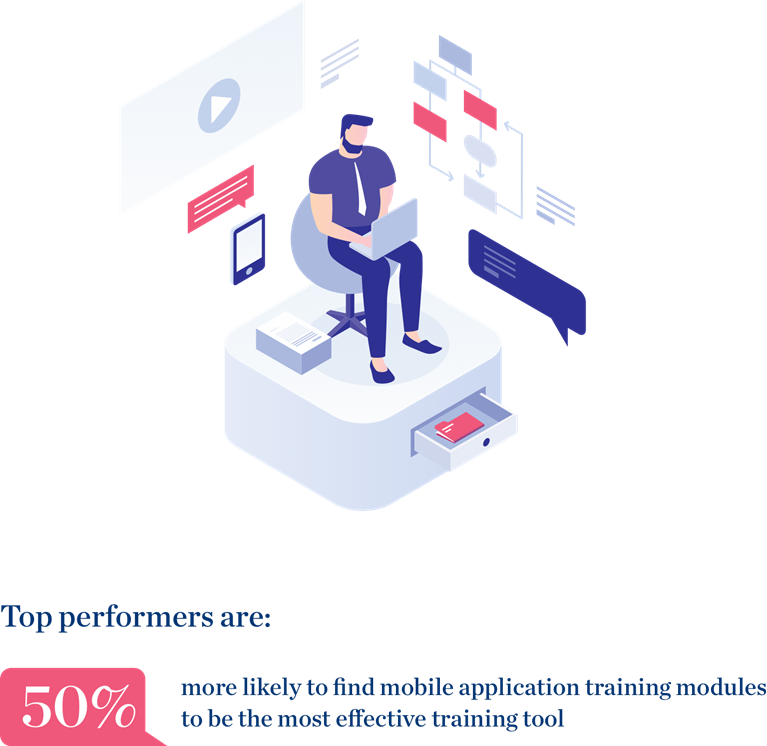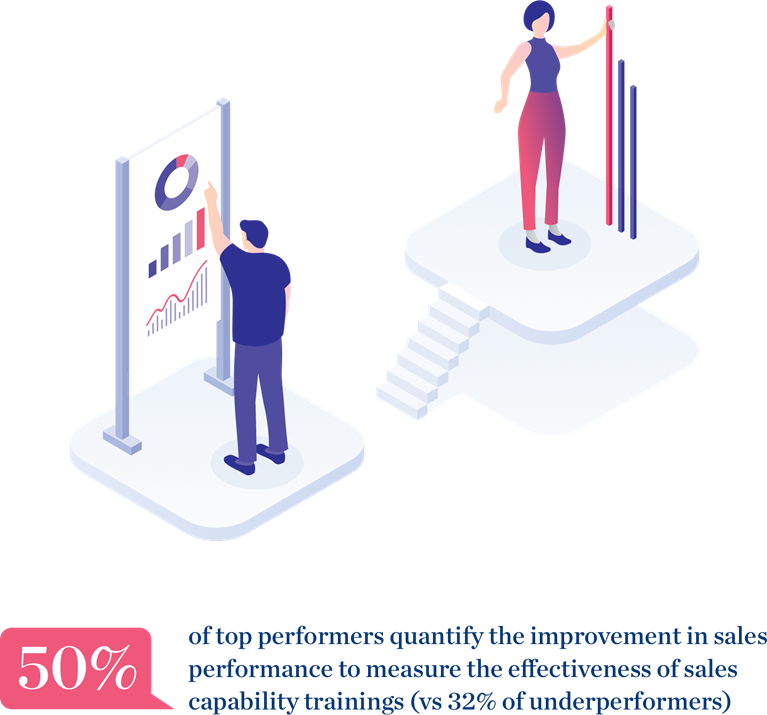Despite the fact that a significant portion of a company’s value creation rests with its sales force, there are significant differences between how fast-growing companies (outperformers) and slow-growing companies (underperformers) invest in and equip their sales teams.1
Stay current on your favorite topics
In a global, cross-industry survey of approximately 1,200 respondents across various sales roles from leadership to the front line, we unearthed five best practices that separated the outperformers from the rest.
1. Sales executives own capability building for the long haul

Senior executives in outperforming organizations embrace capability building—often making it their top priority. In less progressive organizations, training program design and accountability for participation is owned by the learning-and-development function without business partner input or, worse, outsourced to a third-party sales training company.
Our research also indicates that it is all but impossible for any capability building to achieve the desired commercial and behavioral results unless the captains steering the ship are also equipping the crew with the right tools. And that requires understanding the root causes affecting sales performance.
The head of sales at a global enterprise IT-services provider wanted to design, build, and execute a brand-new approach to capability building. Prior experience showed that spending on training had a limited return on investment and delivered little tangible behavioral change. Before building one piece of training material, therefore, he and his team designed a capability-building program that targeted the root causes that were limiting the sales force’s ability to deliver against the company’s strategic growth priorities. The company ended up with a certification-based program for managers and sellers that helped the sales force better understand customer needs and position the broader portfolio.
Another issue is that training programs go through a cycle where participation spikes for the first couple of months after launch when excitement is high. Then participation falls away. The sales-leadership team at the enterprise IT-services company understood this and remained visible at the forefront of the program for the long haul. They celebrated program wins at town halls, rewarded commercial success, and rolled up their sleeves in monthly progress reviews to assess the program’s effectiveness.
The program has been running for more than three years and, thanks to the commitment of sales leaders, it has delivered more than $150 million in incremental business.
Would you like to learn more about our Marketing & Sales Practice?
2. Tailor program design and content to the sales rep

Top-performing organizations boost the return on their training by ensuring that it is personalized to the audience and unique to their organization and selling process. They do this in two specific ways.
First, top performers make the effort to identify the skills required to deliver their company’s business and sales strategies. They then identify what capabilities they already have and which ones they need to develop to deliver their objectives.
Second, our survey discovered that outperformers do not generally use off-the-shelf sales training materials. Instead, they customize training materials to match the specific needs and priorities across different roles and functions. They understand, for example, that the needs of sales specialists are very different from those of sales-support staff, which are in turn different from those of inside sales telemarketers. Best-in-class players design programs and material that are aligned to the specifics of how sales reps sell to customers.
A global leader in enterprise technology was transforming its commercial go-to-market model. Sales leaders knew they needed to upskill their people, so the company invested heavily in training programs. They identified what type of training the distinct groups within the sales function needed at a granular level across regions based on the skills they required in the new model. Then they created “learning journeys” for each different role, from diverse types of frontline sellers, to account managers, to support staff, to senior sales leaders. For example, specialized frontline sellers needed to focus on collaborating more effectively with each other and with sales support. Therefore, their tailored learning journey focused on improving this critical skill of collaboration, with various elements of e-learning, in-person workshops, fieldwork, and more.2
3. Make sales managers the agents of change

Best-in-class companies put their managers front and center in the training effort rather than simply outsourcing it or mandating participation. Outperformers clarify the critical role all managers have in the rollout of training programs and in integrating learning into day-to-day activities. They also identify a few managers as master trainers and give them the time to perform their role effectively. In fact, outperformers are much more likely to have managers who spend at least 20 percent of their time coaching.
Specifically, outperformers:
- Design a manager-specific certification learning journey (typically with a heavy focus on coaching and performance management)
- Provide managers with a clear role at the front of the classroom, teaching and role-modeling the frontline seller content
- Engage managers to help sellers complete measurable tasks in the field, ensuring frontline sellers apply classroom lessons in real client situations
High-impact coaching can come in many flavors. Instead of issuing a series of sales directives as had been the custom, the head of sales at one North American consumer-services company had managers lead a series of in-person sessions and conduct targeted drive-alongs focused on in-field coaching. By focusing on specific skills and enforcing their use with concrete goals, sales leaders raised rep productivity by 25 percent within 18 months.
All high-performing sales organizations that we encountered make extensive use of role playing as a coaching technique. The practice has proven especially effective in helping sales teams improve soft skills, such as navigating difficult conversations. One large B2B player conducts deal rehearsals in front of sales managers and other senior executives to help reps build muscle memory, so that they can articulate the company’s value proposition. This is just as important for well-established sales reps as for newer hires.

The secret to making it in the digital sales world: The human touch
4. Use multiple formats to make the learning stick

Outperforming companies typically use a variety of formats (including digital media) to combat the poor retention rates of traditional classroom training. Capability-building modules are designed and deployed with an array of reinforcing mechanisms, including notifications and communications, ranging from daily push notifications to a sales-training app to downloadable short training modules that reps can use between customer meetings.
Top sales organizations often use digital and mobile applications to help extend the frequency and reach of learning opportunities as well. In fact, outperforming companies invest in mobile application modules because sales reps are 50 percent more likely to find them highly effective for learning new skills, according to our study.
The enterprise technology provider we mentioned above reinforced key concepts through e-learning modules that then were applied in daily routines. These modules included interactive elements and videos from experts on subjects such as how to tailor a value proposition, which reps could then practice on the job.
In addition, frontline sales staff had to record their own value-proposition delivery—ostensibly the elevator pitch—using a digital platform that allowed managers to observe sellers and their behaviors. These mini-testimonials were then benchmarked by assessors, and the top performers’ pitches were disseminated to highlight best practices. Managers did their own assessment of the videos, but also received flags where there were important gaps so that they could provide coaching. The innovative approach delivered a 5 percent quarter-on-quarter sales increase for those reps whose skills demonstrably improved.
5. Measure success based on commercial results

Although many organizations deploy training, most do not actively measure its success. They often measure “housekeeping” metrics such as participation, module completion, or workshop attendance, but fail to look at commercial ROI.
Our research indicated that outperformers were 56 percent more likely to measure the effectiveness of sales capability trainings and quantify improvement in sales performance.
At one IT services company, every participant in the training program was required to complete a series of on-the-job activities that matched each classroom training module. To support this approach, both frontline sellers and their sales managers were asked to use the lessons they had learned in the classroom in their next real-life sales conversations.
For each post-workshop activity, the sellers and managers started a new CRM entry for that specific opportunity, which enabled the organization to understand the impact the training was having. This relentless desire to track impact helped show the program had delivered more than $150 million of new commercial growth. Even better, participants in the program were growing their sales pipelines faster than those who did not participate.
By investing in their people using thoughtful and strategic capability-building programs, sales leaders can empower their sales force, maximize the experience of their sales managers, and collectively drive sales growth.


